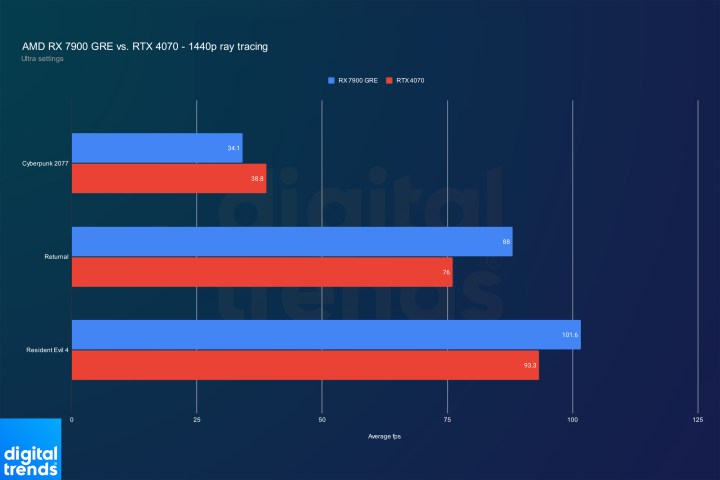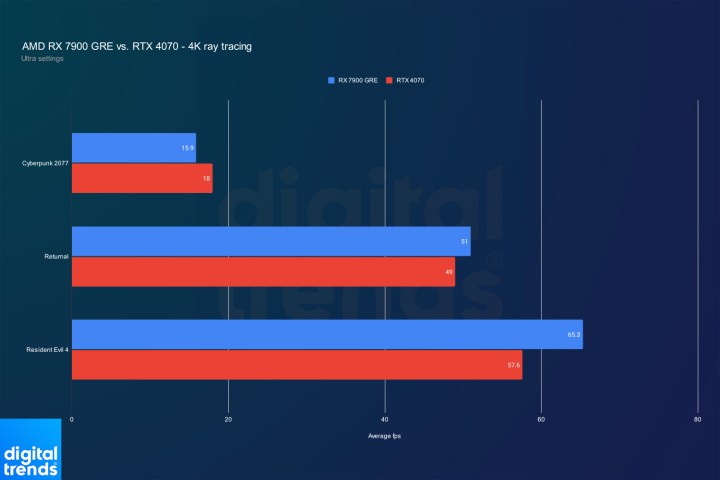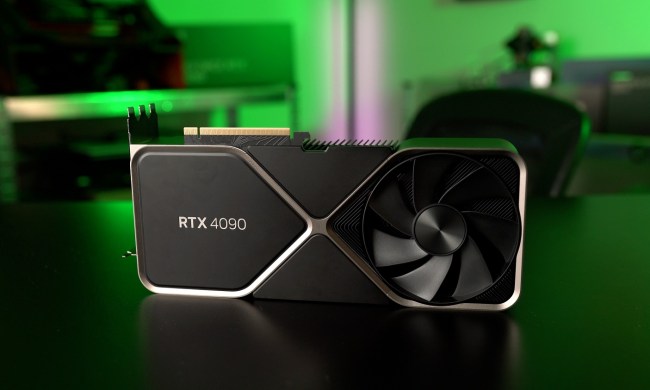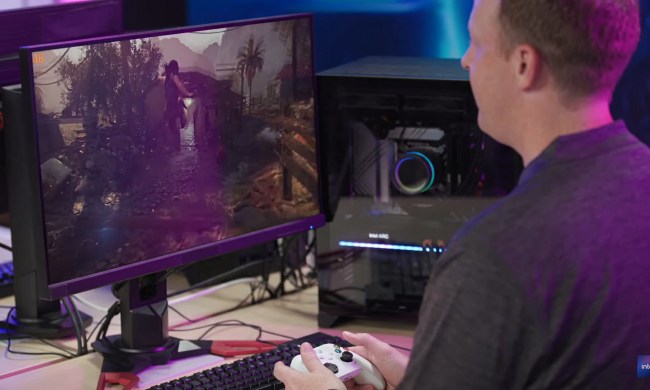
AMD just released the best RDNA 3 graphics card we’ve seen yet in the form of the RX 7900 GRE. The GPU, originally released in China several months ago, sets its sights squarely on Nvidia’s RTX 4070 — and AMD comes out on top most of the time.
I’ve tested both GPUs extensively — read my RTX 4070 review and RX 7900 GRE review for a full breakdown — and I’m here to compare them point-for-point. AMD comes out on top for raw performance, but there are a couple of key details to keep in mind before making your final buying decision.
Pricing and availability

The RX 7900 GRE and RTX 4070 have the same list price of $550, but the actual price you’ll pay is a bit different. The RX 7900 GRE is readily available at $550. Prices will likely drop at some point, but for the time being, AMD’s latest GPU is holding steady at its list price. There are some overclocked models available that increase the price by around $50.
Nvidia’s RTX 4070 is a bit tricky. The card is officially $550, but retailers commonly mark down the price on the card. At the of writing, for example, the is available for $530.
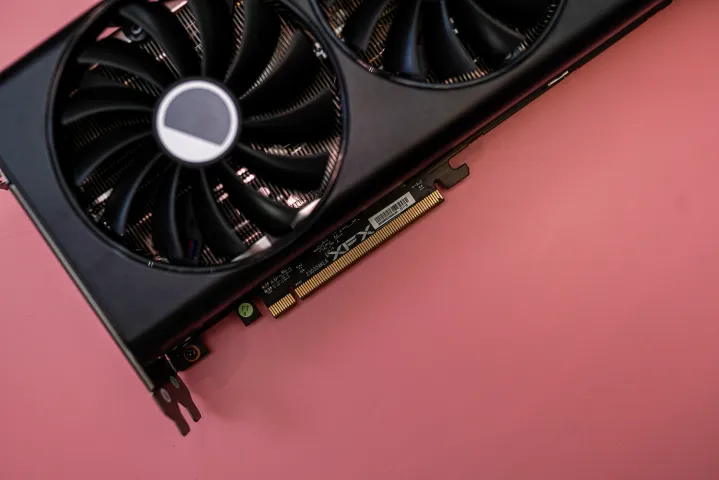
That’s a typical price, too. In the past, especially during a large sale, I’ve seen the RTX 4070 for as little as $500. The RTX 4070 and RX 7900 GRE carry the same list price, but the floor of pricing for the RTX 4070 is much lower. You have a lot more opportunities to score a deal.
That’s even more true when you look at the secondhand market. I’ve seen the RTX 4070 go for around $430 on eBay, which is leagues cheaper than what you’ll find the RX 7900 GRE for. Eventually, we’ll see more RX 7900 GRE models on the secondhand market, but the RTX 4070 is much older, so you have a much better chance to find one used — and at a good price.
Specs

As usual, it isn’t worth comparing the high-level specs of an AMD and an Nvidia GPU. The core counts and clock speeds are vastly different, with each interacting with their respective architectures in a different way. The two important areas to pay attention to are power draw and the memory interface.
Starting with power, the RX 7900 GRE consumes much more than the RTX 4070. The maximum wattage of the RTX 4070 is 200 watts, while the RX 7900 GRE climbs up to 260W. In practice, there’s an even wider gap. The RTX 4070, like all of Nvidia’s current-gen GPUs, is highly efficient, so it’ll often run below 200W in gaming scenarios. The RX 7900 GRE climbs to the top of its power range more often.
| RX 7900 GRE | RTX 4070 | |
| Cores | 5,120 | 5,888 |
| Memory | 16GB GDDR6 | 12GB GDDR6X |
| Memory bus size | 256-bit | 192-bit |
| Clock speed | 1.88GHz | 2.48GHz |
| Connection support | DisplayPort 2.1 | DisplayPort 1.4 |
| Total board power | 260 watts | 200W |
| List price | $550 | $550 |
The RX 7900 GRE’s high power draw might have something to do with its more robust memory interface. The card comes with 16GB of GDDR6 memory across a 256-bit bus. The RTX 4070 uses a smaller 192-bit bus, along with 12GB of GDDR6X memory.
VRAM shouldn’t be an issue with either of these GPUs, at least in most games. The only exception are VRAM-hungry titles at
Performance
Looking across a range of games, the RX 7900 GRE is faster than the RTX 4070. On average, it’s around 12% faster at
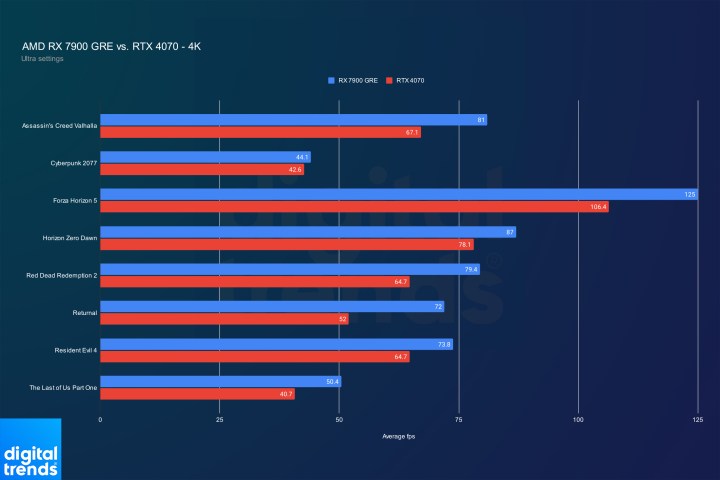
It’s not just that the GRE is faster overall. You can see how it manages to clear the bar for playable
There are titles where the GPUs are much closer, namely Horizon Zero Dawn, Cyberpunk 2077, and Resident Evil 4. Even in these games, the lead of the RX 7900 GRE isn’t insignificant, however.
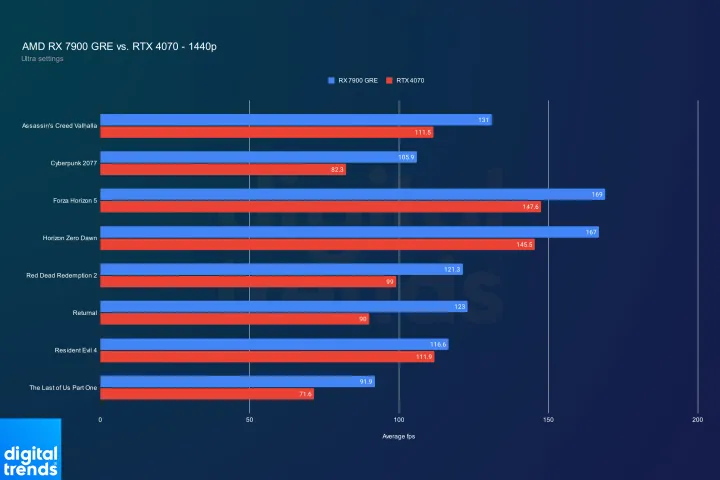
Things change down at 1440p, but the RX 7900 GRE still comes out on top. Although the overall lead is more signficant by the numbers, the difference in experience isn’t as noticeable at 1440p. Forza Horizon 5 and Horizon Zero Dawn are good proof of that. The RX 7900 GRE has a signficant advantage, but both GPUs are providing enough performance to saturate a 144Hz monitor with ease.
We can also see the RX 7900 GRE shine more in titles like Cyberpunk 2077, as the CPU is brought into the mix more in the final performance you see. On the other hand, games like
How about ray tracing? The RX 7900 GRE, surprisingly, holds up better than the RTX 4070 does. You can see that in both the
This is where the RTX 4070 really shines. The RX 7900 GRE stays competitive with the RTX 4070 in
Even so, the RX 7900 GRE is much faster, and it comes in at the same price. For performance, the only way to justify the RTX 4070 is if you’re really after those prestige gaming experiences like Alan Wake 2 and Cyberpunk 2077 — and you’re willing to sacrifice quite a bit of performance in other titles in the process.
DLSS and FSR

When it comes to features, the RTX 4070 bites back. Although it loses in performance to the RX 7900 GRE, the RTX 4070 supports Nvidia’s DLSS 3.5. That gives you access to not only higher-quality upscaling and frame generation, but also Nvidia Reflex and Ray Reconstruction, with the whole package coming together for very demanding titles like Alan Wake 2.
AMD, for its part, has FSR. The upscaling in FSR 2 is solid, but it’s behind DLSS in overall quality. And the frame generation in FSR 3 is impressive, but it’s only available in a small list of games. AMD has a counter for each of Nvidia’s features, but the usefulness of them, at least right now, doesn’t hold up. Nvidia has a pretty signficant lead with DLSS 3 in game support.
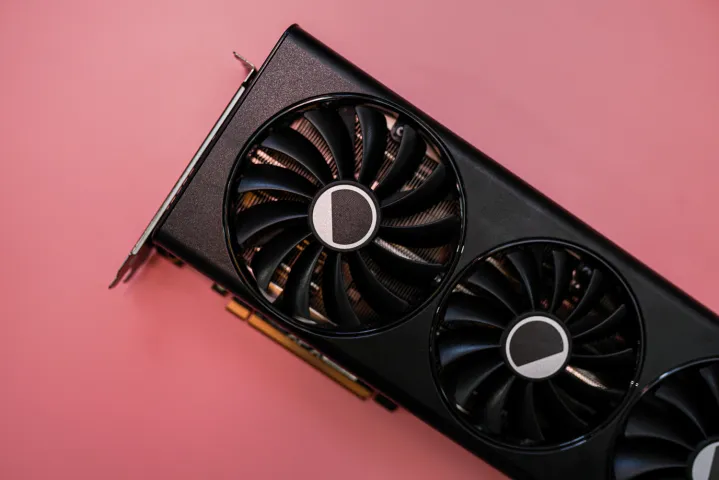
There’s one area where AMD stands out, however. You can use AMD Fluid Motion Frames (AFMF) through the AMD driver with the RX 7900 GRE, applying frame generation to thousands of DirectX 11 and DirectX 12 games that otherwise wouldn’t support the feature. AFMF has a fair share of problems, but it’s still a nice feature to have if you want to boost performance in games.
Even with FSR 3 out and AFMF available as a backup, Nvidia has an undeniable lead when it comes to features. The DLSS 3.5 package is fantastic in supported games, so much so that it’s even worth trading some performance to unlock that features package — just not as much performance as the RTX 4070 trades.
A raw performance advantage
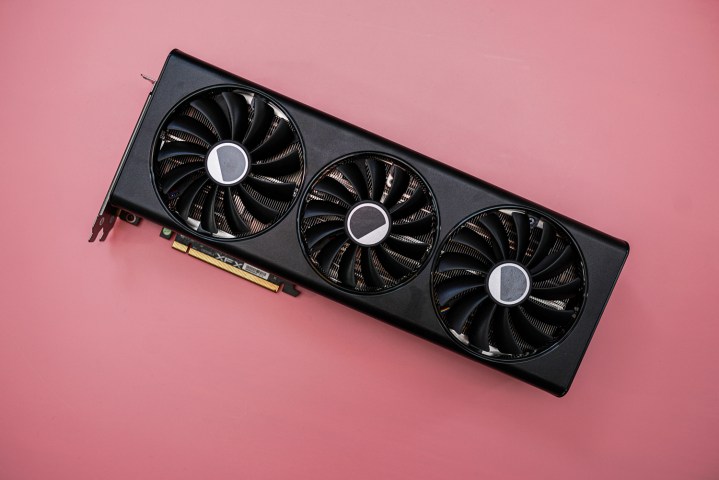
Nvidia’s RTX 4070 was an impressive GPU throughout last year, but it’s starting to fade in 2024. The RX 7900 GRE is stiff competition from AMD, and even with Nvidia’s impressive list of features, the RTX 4070 can’t keep up with the raw performance advantage the RX 7900 GRE offers. At this price, the RX 7900 GRE is the graphics card to buy.
Although the RTX 4070 is down and out, it doesn’t mean Nvidia is overall. The RTX 4070 Super is available at $600, and it manages to match the performance of the RX 7900 GRE while offering Nvidia’s list of features.

